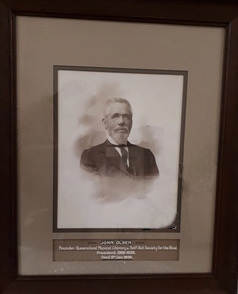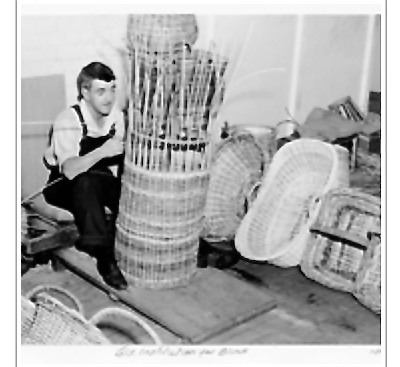Royal Queensland Society of Blind Citizens Building

The building at 247 Vulture Street, on the corner of Vulture Street and Stephens Road in South Brisbane has an interesting history dating back to the early 1900s. It is a story of inspiration, commitment and triumph over adversity of a community who, although visually impaired, lead a rich and happy life. It all began with the dream, inspiration, hard work and commitment of one man, John Olsen.

John Olsen (1852-1926) was born in Norway and immigrated to Australia at the age of 21. He lost his sight in a serious accident when he was thirty, but this did not stop him from leading a fulfilling life dedicated to community service and looking after the blind and visually impaired. He was a preacher and teacher in the Baptist and Christian Churches, and a librarian and teacher of Braille. He worked as a basket weaver at the Queensland Blind, Deaf and Dumb Institution in Cornwall Street, Annerley. His charismatic nature and positive outlook on life endeared him to everyone he met.

On 13 March 1917 he established the Queensland Musical Literary and Self-Aid Society for the Blind (QML) which was to be run by blind people to assist the blind. The main objectives were to promote the study of vocal and instrumental music, literature and writing; to give financial aid to students; and to provide a recreational and educational building for the blind.
John Olsen was the Society President from 1919 until his death in 1926.

In 1924 the QML bought a property at 247 Vulture Street and converted the old residence on it for use as their base, becoming known as the Queensland Technical School for the Blind.
After a few years they decided to erect a new, more suitable building which would become their club rooms.
A Spanish-style white stucco building with terracotta tiled roof was completed in 1933. It consisted of offices in the front, a lounge room, a music room, a concert /dance hall for up to 400 people and a supper room in the basement. One of the offices contained the library of the Queensland Braille Writing Association with over 4000 books available to members.
The Blind Institute Hall as it was known, fulfilled an important social role for those who worked at the Industrial Institution (School) for the Blind at Dutton Park as they would come to the society for recreation and entertainment after work. They were also able to develop musically, with the society providing interest free loans to members to buy radio sets and musical instruments.
An article in the Sunday Mail of 18 February 1934 describes the members as “ a contented little community, sharing each other’s joys and sorrows, laughter and tears. They are drawn together by the common bond of a great affliction, but they find in the club-rooms much of the happiness that persons of normal vision may never see.”
The Blind [Institute] Hall became a popular venue for regular dances open to the local community and many community events. During World War II the building was occupied by the USA Army which used it as a Post Office.
John Olsen died on 9 January 1926 and was buried in South Brisbane Cemetery. A memorial stone was placed at his grave site and a memorial tablet was put up in the Blind Hall in recognition of his selfless service to the community.
The QML was dissolved at its final meeting on 19 November 1974 and all assets passed on to the Queensland Society of Blind Citizens. In 1986 the name was changed to Royal Queensland Society of Blind Citizens.
In November 1993 the premises were sold for $340,000 (realestate.com.au) but the Hall continued to be used as a dance studio and fitness centre. It is now part of the adjoining St Nicholas Free Serbian Orthodox Church.
247 Vulture Street was entered on the BCC Local Heritage Register (LHR) on 30 October 2000 in recognition of its ‘strong and long-lasting connection with residents of South Brisbane who have attended the hall for a variety of social, recreational and developmental activities since it was completed in 1933. It is also significant as a rare example of the Interwar Spanish Mission style adapted to an institutional building. (LHR)
(sources: BCC LHR/ Trove articles/Vision Australia/)
Brisbane Convention & Exhibition Centre
The Brisbane Convention & Exhibition Centre (BCEC), corner Merivale Street and Grey Street, South Brisbane was officially opened on 6 June 1995.
This world-class convention centre is part of the post Expo development of the South Bank area which had hosted the successful World Expo 88 from 30 April to 30 October 1988.

The need for a world standard convention facility for Brisbane goes back to the early 1980s when Brisbane was the only capital city without a dedicated Convention and Exhibition Centre. This meant that Queensland was missing out on the rapidly growing lucrative trade and exhibition market and its financial and tourism benefits. While at the time many hotels were catering for conventions they would not be able to cope with the expected larger scale international conventions, trade exhibitions, sporting and cultural events.
An inter-departmental Government committee was formed which discussed various ideas and plans, visited venues in other states and finally decided that a new international standard facility would definitely be built in Brisbane. The site chosen was a 41-hectare land parcel at the back of the old Expo site on the former Expo Fun Park. The land was owned by the South Bank Corporation which was established in 1989.
The location was ideal: it was behind what would become the new South Bank Parklands (opened in 1992), was close to the city and easily accessible, opposite the South Brisbane Railway Station and near a transport hub.

Submissions were called for and an innovative design by Philip Cox and Associates who had also designed the Darling Harbour Exhibition Halls was accepted. Tenders were called in August 1992 and the contract was awarded to Leighton Contractors. Construction started in March 1993 with the demolition of World Expo Park. The BCEC was completed in May 1995 and opened on Queensland Day, 6 June 1995. The building cost of ca. $170 million was funded by the State Government with proceeds from the sale of the Brisbane Casino Licence. An unforeseen cost blow-out raised the cost to $203 million. The BCEC is owned by the State Government and was managed by ASM Global, and now AEG Ogden, both international venue management specialists.
The first major event for the new building was the Brisbane International Motor Show held in February 1996. The Show used all five halls and was a great success and set the scene for future events on a grand scale.

Rapid growth and the need to keep up with modern trends meant that there was a need for the Centre to be expanded. Expansion plans by architectural firm Cox Rayner were approved in 2007, construction started in 2010 and was completed in early 2022, with the opening on 25 January 2012. Total cost of the expansion was $140 million.

The Convention Centre now has a total space of 171,000 m2 , a huge exhibition hall floor, ballrooms, theatres and boardrooms and underground parking for 1500. It has hosted many major local and international functions and conventions including the 2014 G20 Brisbane Summit. The Great Hall was the official home of the Brisbane Bullets and the Gold Coast Blaze National Basketball League, as well as the Queensland Firebirds in the Australian Netball League for some years.

Over the years the BCEC has won many industry awards, including the 2016 and 2017 Greener Suburbs Award. It is currently being considered a possible venue for badminton, fencing and Taekwondo for the 2032 Olympics.

The successful and popular event and convention centre has certainly achieved its goal of enhancing Brisbane’s international marketing profile. It offers flexible and contemporary facilities for a variety of functions both large and small such as conferences, conventions, gala events, exhibitions, concerts, meetings, seminars and workshops.
(Sources: www.bcec.com.au; southbankcorporation.com; wikipedia; document.parliament.qld.gov.au; www.afr.com; brisbanetimes.com.au)
